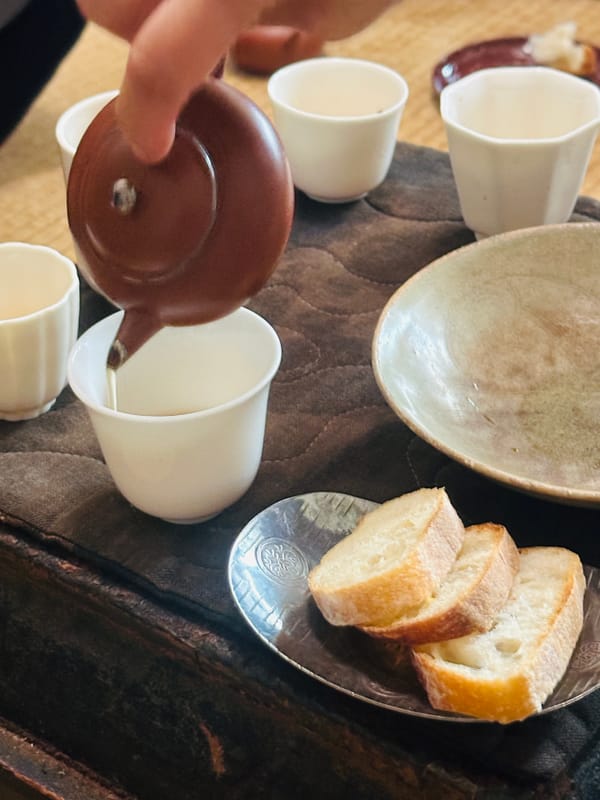If wine is the longtime companion of the French baguette, then what about tea? One quiet afternoon, who would have thought that a simple baguette could quietly awaken the deep aroma of a roasted tea? Roasted Tieguanyin and the French baguette—two seemingly unrelated things—met unexpectedly, and in that moment, gently shook hands upon the tastebuds.
A Loaf of Bread, the Warmth of a Nation
Do you remember your first bite of a French baguette? That crispy crust and soft interior said goodbye between your teeth with a whisper, leaving a lingering memory on your tongue. Known as the baguette, this bread is more than a staple—it is a silent guardian of French culture, witnessing the passage of time. It carries not only the purity of flour and water but also a nation's pride. So much so that on November 30, 2022, it was inscribed on UNESCO’s list of intangible cultural heritage.
French President Emmanuel Macron once described it as “250 grams of magic and perfection.” In a world full of change, a simple combination of flour, water, yeast, and salt has become an enduring symbol of France. It’s not merely food—it’s poetry in physical form, a small miracle in everyday life.
The Precision of Baguette, the Romance of France
The traditional French baguette follows nearly sacred rules. No chemical additives or improvers are allowed—safeguarding a belief in purity. Its size and weight resemble a precise sonnet: about 65cm long, 4–6cm wide, 3–5cm high, and roughly 250g in weight. If it falls short by more than 4 grams from the listed weight, it violates French consumer law. This attention to detail may, in fact, be another form of French romanticism.
Behind Tea’s Fragrance: A Dialogue of Fire and Time
In the East, roasted Tieguanyin follows a quieter path. Medium-roast Tieguanyin is the gateway for many tea lovers entering the world of fire-roasted tea. Each leaf tells a tale of intimate dialogue between flame and foliage. The “baking” stage gently removes moisture, while the “roasting” stage seals in sweetness. This is not just tea-making—it is a refined alchemical ritual, preserving the leaf’s integrity while slowly revealing its roasted character over time.
Roasting is the tea’s silent transformation. Under different levels of fire, the same tea leaf reveals different personalities: light roast is like a youth, retaining floral vibrancy; medium roast is a mature adult, steady and rich; deep roast is the elder, wise and contemplative, with a lasting sweetness that lingers at the base of the tongue like quiet wisdom.
A classic tea proverb says: “Tea is the monarch, fire is the minister.” The highest form of roasting isn’t about domination—it’s about refinement. It brings out the tea’s natural beauty and can even revive aged tea leaves, awakening dormant vitality. This is the humility of fire—and the magic of time.
A Flavorful Encounter: More Than Just Taste
Sometimes the most harmonious pairings are unannounced. What happens when East meets West at the table?
One serene afternoon, imagine holding a warm cup of medium-roasted Tieguanyin in your left hand and a freshly baked French baguette in your right. Sip the amber tea first, let its warmth flow slowly across your palate. Then take a bite of the baguette—when your teeth crack through the crust, it’s like opening a door to another world.
Compared to pastries, a baguette with roasted tea offers a deeper, layered flavor experience. The medium roast Tieguanyin, having undergone time’s refinement, presents a full-bodied character. When it meets the baguette’s crisp, flaky crust, it feels like a wordless duet. The natural sweetness developed in the baking process echoes the caramelized notes formed during the tea’s roasting—creating a delicate balance.
This is not a coincidence. It’s a dialogue between roasted tea and baguette. The tannins released during roasting and the Maillard reaction’s toasty aromas harmonize with the baguette’s soft-crisp texture. As the warm tea soaks into the crust, softening its defenses, the tannins begin to unfold in the mouth. From tip to root of the tongue, from sharp heat to gentle warmth, the experience blossoms: wheat and tea intertwine, offering a complex, dimensional delight.
Between Roasting and Crunch: Finding the Perfect Distance
How you drink roasted Tieguanyin depends on the unspoken connection you share with it. But when paired with a baguette, this relationship becomes even more nuanced. Not all roast levels go well with baguettes. A lightly roasted tea is too green to match the richness of wheat aroma. A heavily roasted tea’s char will overpower the bread’s gentle flavor. But medium-roasted Tieguanyin finds that golden balance—neither overwhelming nor submissive, yet still distinct.
It’s much like what we seek in life: not too much, not too little—the just-right harmony is the most precious.
When roasted Tieguanyin meets the French baguette in your flavor landscape, you experience a dimensionality that’s hard to describe. From the crust’s slight resistance against your gums, to the tea’s silky glide across your tongue; from the initial sweetness sensed at the tip of your tongue, to the deep aftertaste at its root—even the warm echo in your throat—this is no longer just taste. It is a multisensory journey. Each sip and bite feels like rereading a familiar poem, discovering new verses each time.
Let Tea Lead You on a Different Path
On a sunlit afternoon, if you wish to add a new shade to your daily palette, why not take a path less traveled in your tea pairing?
Find a fresh French baguette, preferably one crafted with traditional methods—golden crust like a canvas, soft interior like a cloud. Brew a pot of medium-roast Tieguanyin. Let its aged fragrance slowly spread through the room like a whispered poem.
While the baguette still holds its warmth, sip your tea, then take a small bite. Close your eyes and let your senses absorb it all—the woody tea aroma dancing with the wheat fragrance; the tea’s smooth texture intertwining with the softening bread. This is more than flavor—it’s a conversation across cultures.
In a world that rushes, taking a moment to savor the simple joy of tea and bread might just help us rediscover the beauty hidden in plain sight.
When the roasted charm of Tieguanyin meets the soul of a French baguette, two distant cultures meet silently on the tongue. Within this seemingly modest encounter lies a profound dialogue across time—and an unspoken understanding beyond words.
Some encounters are meant to be quietly savored.


